I wanted to take my cat on a hike in L.A. What could possibly go wrong?
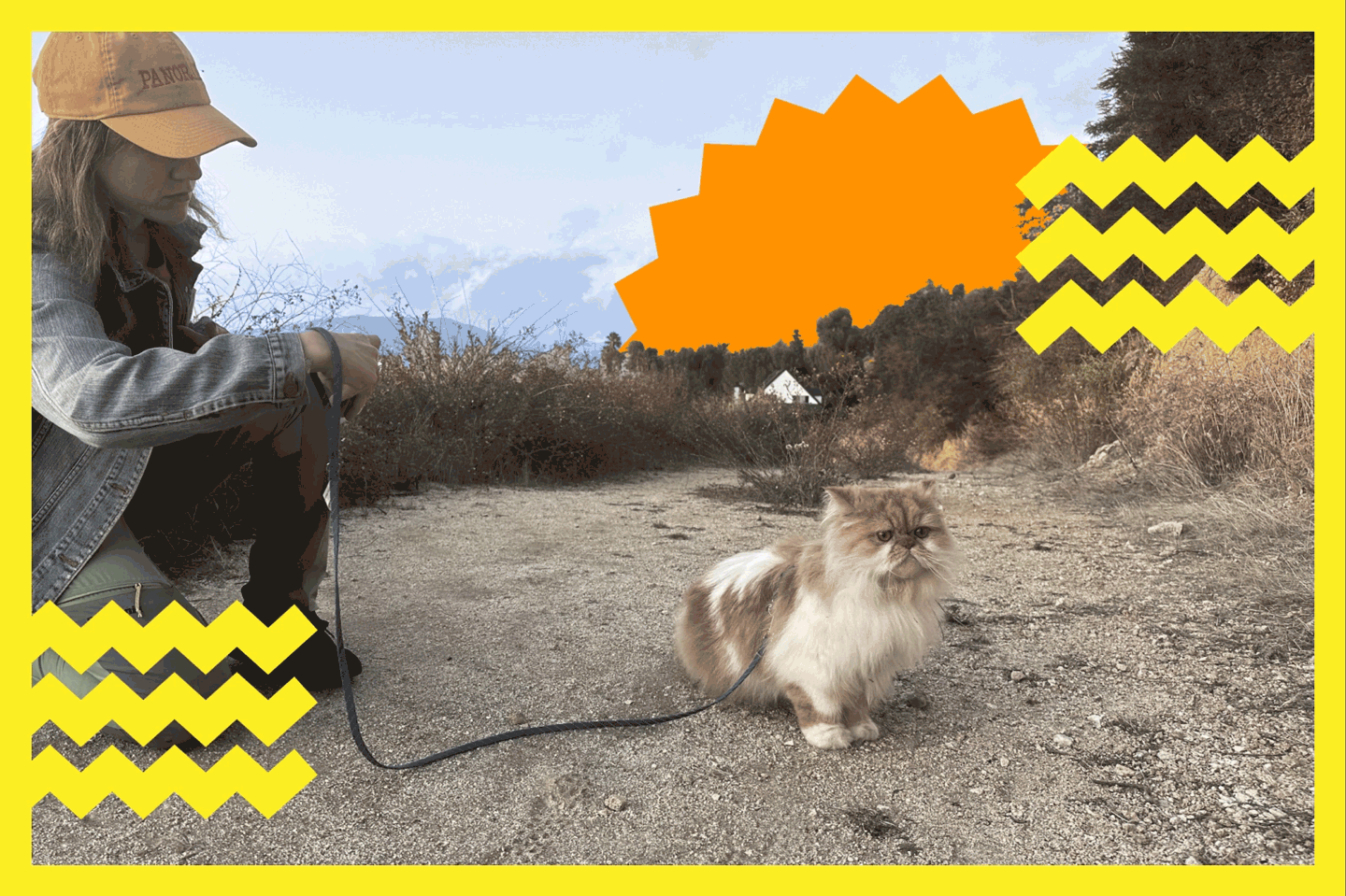
- Share via
Editor’s note: The Wild is all about featuring a variety of exciting voices from SoCal’s outdoors scene. For the next several weeks, that voice will belong to Times staff writer Lila Seidman. A native Angeleno who joined The Times in 2020, she’s investigated mental health policy and jumped on breaking news, and is excited to embark on a new adventure writing about the outdoors in her home state. She loves trail running in the mountains near her Tujunga home and revels in the continuous realization that Los Angeles always has more to offer. And, as you’ll read in this newsletter, she’s also mom to an increasingly intrepid cat.
Growing up with a rotating cast of felines in central Los Angeles in the late 1990s, it never crossed my mind to try to walk any of them. It seemed like a recipe for a nasty scratch.
Yet, when I took home an orange-and-white, flat-faced floof a little over a year ago, I resolved to give it a shot.
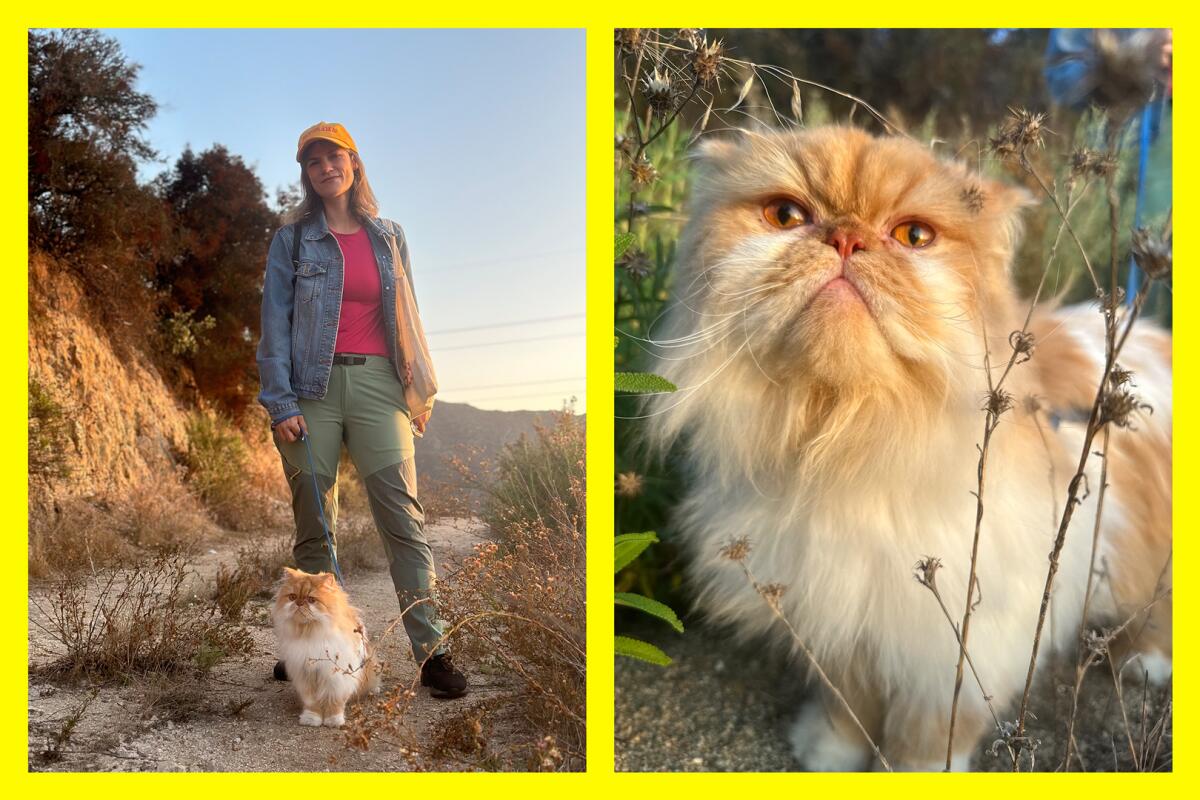
My cat, Orson, is a Persian. The breed is known for enjoying warm laps, not the great outdoors. But he’s spunky. I wanted to give him the best life — and that didn’t seem like indefinitely pacing around the shoebox-sized North Hollywood apartment where we lived at the time.
My best friend pushed back. He accused me of trying to mold Orson in the image of Instagram-famous adventure cats. His tune changed when he saw how much Orson loved to walk on a leash. The cat enjoyed it so much that he began to sit near the door and yell when he felt he’d spent enough time within the oppressive confines of four walls.
Get The Wild newsletter.
The essential weekly guide to enjoying the outdoors in Southern California. Insider tips on the best of our beaches, trails, parks, deserts, forests and mountains.
You may occasionally receive promotional content from the Los Angeles Times.
Looking back, though, I’m certain that social media played a role in planting the seed of curiosity. I follow cats on Instagram that don’t just leash-walk outdoors but hike and even surf and ski. How else did my childhood notion that only a cat whisperer could make one walk on a leash transform into, “Maybe I can do this too”?
It’s not just me. Interest in ushering indoor cats out of doors has exploded in recent years. But is the impulse good for cats? It turns out the matter isn’t settled among those who train them.
“It is controversial in a lot of ways,” said Marilyn Krieger, a cat behavior consultant based in the Bay Area, who is firmly opposed to the adventure-cat trend.
There is general agreement, however, that Instagram, TikTok and other social platforms are fueling interest and normalizing the concept.

To adventure or not to adventure
Jackson Galaxy, a celebrity cat behaviorist and former host of Animal Planet reality series “My Cat From Hell,” said he fields questions related to walking cats “all the time” — from clients, social media followers and even people in the supermarket. Quite a contrast, says the San Fernando Valley resident, from 10 years ago when he walked a cat down the street and onlookers pointed and laughed because it was such an unusual sight. These days a cat on a leash ruffles fewer whiskers.
Galaxy is a big cat-walking proponent — as long as the cat is into it.
“It’s a great way of enriching your cat by giving them a little bit of what they lost, to be honest,” Galaxy told The Times, a nod to urbanization that he believes makes it too dangerous for cats to roam free.
“Their natural state is to be out there and exploring everything, from a bush to bugs to scratching on a tree, and harness training is a fabulous way of making that compromise where they’re out but they’re safe.”

According to Samantha Bell, a Hollywood-based cat expert for the animal welfare organization Best Friends Animal Society, the hype around out-and-about cats also could lead to more pets finding their forever home.
“I love it because I want more people to want cats, to adopt them, to get them out of our nation’s shelters,” Bell told The Times. “Anything that promotes cats in a positive light — in a new light — I’m thrilled with it.”
Not everyone feels Fluffy belongs in the wilderness.
Cat behaviorist Hannah McCoy highlighted the manifold dangers that leashed cats face, particularly in the hubbub of L.A. There’s no telling, she said, when an unleashed dog might spring from nowhere or a texting driver will swerve too close for comfort. Though McCoy receives several inquiries a week regarding venturing outside, she rarely recommends it.
“It seems … like every other video I see is, ‘I took my cat on a hike to Griffith Park,’ and it just really makes me cringe,” said McCoy, who runs Hannah’s Cat Training. “It’s so incredibly, incredibly, incredibly risky.”
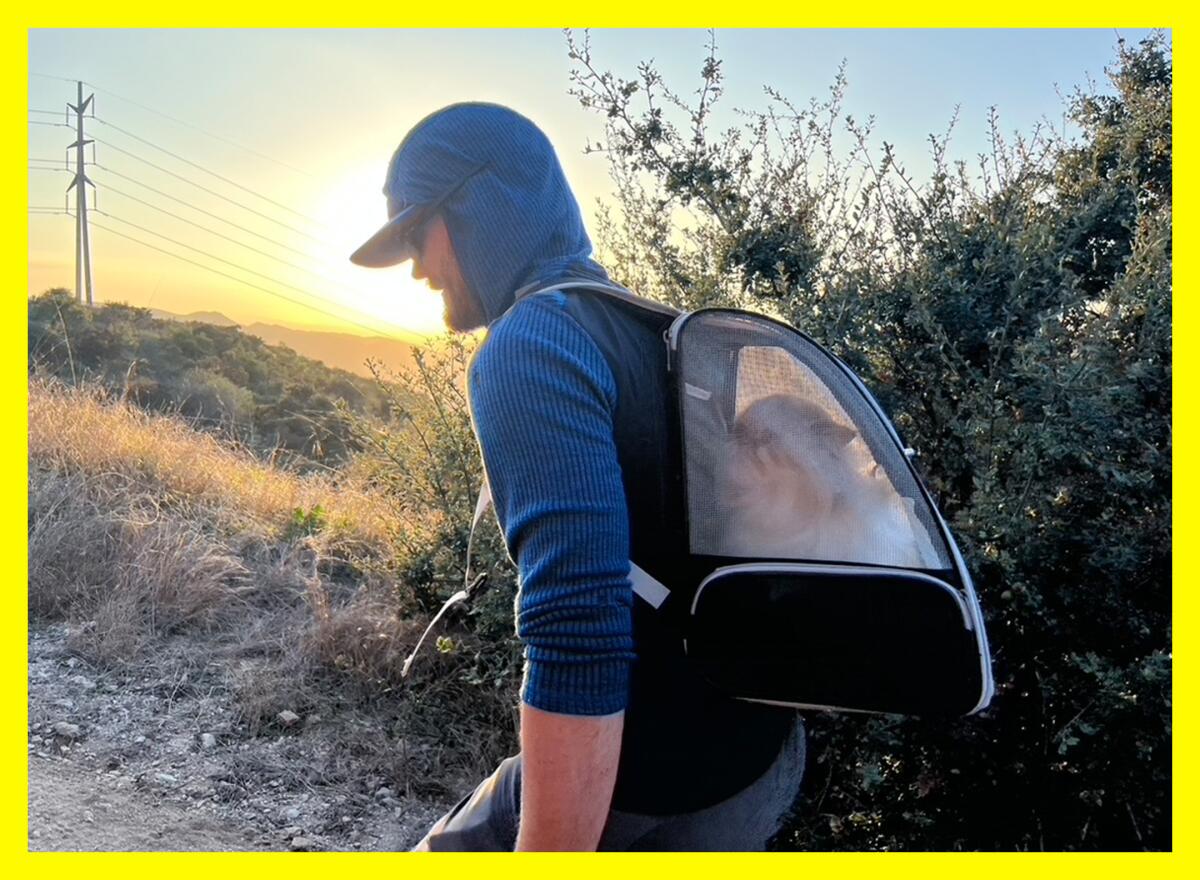
She’d rather see a cat safely zipped inside a stroller, she said, but occasionally makes exceptions for cat owners who have an unusually good bond with their feline companion — and are willing to rigorously train and arm themselves with the necessary gear.
Krieger, who goes by the moniker the Cat Coach, draws an even thicker line in the sand.
According to her, cats are territorial animals, and indoor cats generally see the home as their territory. Taking them out of it can be stressful.
“Frankly, if that’s what people want from an animal that they’re living with, they should have a dog,” she told The Times.
The debate for many is a referendum on risk tolerance — and having confidence that your cat is on the same page as you.
How do the cats feel about it?
James Eastham, co-owner of Gary — a cat who is Instagram-famous for skiing and tackling other sports in the Canadian Rocky Mountains — acknowledged his tolerance for risk might differ from others’. (I find it hard not to “heart” a photo of a cat wearing tiny ski goggles.)
Gary, according to Eastham, is up for it. And when he isn’t, Eastham — a former professional ski patroller — said he respects his cat’s unspoken “no.”
How does he know Gary enjoys heading down slopes? “I guess the question I always pose to people is, ‘Have you ever seen an angry cat?’ Cats are pretty clear about communicating how they’re feeling.”
Because the cat sits on Eastham’s shoulder when they ski, he said he can sense when Gary’s tense or relaxed. (When they hike, Gary has even taken (cat) naps on Eastham’s shoulders.)
Some adventure cats take a more moderate tack. Goma, a 4-year-old rescue, loves strolling on a leash in the mountains near Altadena for a mile or two, according to Max Yasuda, one of his owners.
After that, Goma starts complaining and sometimes lies down on the trail to let his parents know he’s had enough. Yasuda said he hikes the cat home in a backpack — a feat that has become more challenging now that Goma weighs 16 pounds.
“[I]f we don’t take him hiking enough, he sits at the door and meows and begs to go outside,” Yasuda said.
A word of caution: Once they’ve gotten a taste of outside, some cats will develop a habit of trying to dart out the door whether leashed or not, according to several behaviorists I spoke with. So cat custodians contemplating this sort of outdoor adventure should be aware of the risk of creating a door dasher.
Behind the scenes
What often gets lost in the TikTok videos and Instagram posts is all the time, effort and safety considerations that go into cat adventuring.
Gary didn’t immediately go from Alberta house cat to conqueror of mountains. And Goma’s parents observe an extensive list of hiking rules, such as avoiding trails with runners and mountain bikers because “he thinks they are bears,” Yasuda said. Just training a cat to wear a harness can take weeks — and some cats simply won’t abide it.
Galaxy stressed that it’s important to seek “consent before you force them into a harness.”
Some cats, regardless of top-notch training, simply do not want to go out. In that case, it’s important to respect their wishes. All the cat gurus I spoke to agreed on this point.
Galaxy said he wished catfluencers would use their large social media platforms to take the time to educate people about what’s happening behind the scenes.
Thankfully, there is a wealth of free information available online that breaks down how to harness train, advises on the supplies you need and provides insight into what to expect.
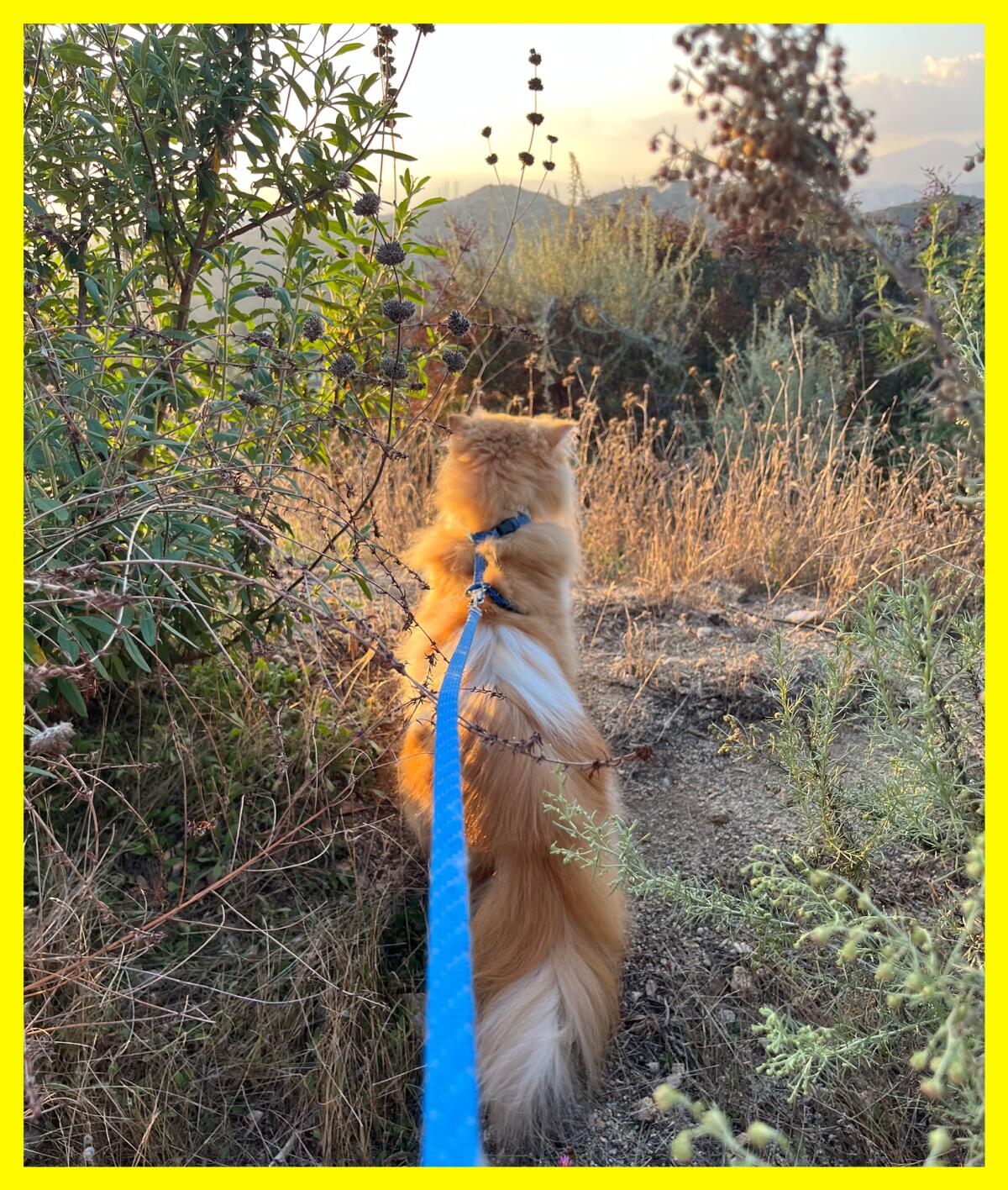
Time to hike
After talking to a whole bunch of cat professionals, I checked in with myself.
Weighing the pros and cons, I decided it was time to introduce Orson to the trail.
For more than a year, our walks had hewed close to home — in the front or back of the two domiciles we’ve inhabited together. I’d learned a lot about his likes and dislikes and how to confront obstacles. We were ready to explore something new. After toying with the idea of hiking for months, earnest scheming began this summer. Two weeks ago, we were finally ready to rock and roll.
And I knew just the place: a practically unused trail tucked in a residential area minutes from the doorstep of my foothills home. The trail’s solitude meant Orson was less likely to get spooked and its proximity to his home territory offered a rapid retreat.
My partner, Emanuel, and I packed water (enough for both humans and cat), treats and a bowl. Then we fitted the harness on our fur son, loaded him into a backpack he’s well-acquainted with and drove over. It was around 5:30 p.m. and 75 degrees. Immaculate blue skies rose overhead. (I strategically planned the outing to occur after an unseasonal heatwave.) We hiked him a few hundred feet into the terrain and clipped on his leash before fully unzipping the backpack.
At first, Orson was confused. He started running in one direction, then another, trying to orient himself. But, within a few minutes, he mellowed and started sniffing here, there and everywhere. I followed wherever he went — except when he tried to head down a steep ravine and I had to hold the leash firm. I pet him and fed him a treat to make him feel at ease. I also sang to him, but I’m not sure to what effect.

It was golden hour. His fur appeared to be bathed in a halo as he turned to look at the setting sun over the San Gabriel Mountains in the distance.
For a few minutes, I let him take in the big wide world before scooping him up and returning him to the meshed safety of the backpack.
The whole “hike” lasted about 20 minutes. I wanted to end on a high note — what cat behaviorists call positive reinforcement.
Later that night, Orson meowed at the door. He was yearning for more wild.
Here are a few lessons I’ve learned on my cat-walking journey:
- Orson walks me; I don’t walk him. Rather than walk straight like a dog, he meanders. This entails a lot of standing around while he sniffs plants.
- My cat startles easily, so we walk in the evening and in areas where we’re less likely to encounter other people and animals, such as our backyard.
- Sometimes he decides he wants to eat something questionable, so I always have to be on alert to intercede.
- If he tries to go somewhere he shouldn’t, I shorten the leash and hold it taut.
- Orson prefers a simple H harness — essentially a loop around his neck and belly connected by a strip of material. Other pet parents swear by bigger harnesses and jackets.
3 things to do

1. Run through the ‘Bu. On Nov. 4 and 5, the 15th Run Malibu will take place on the sands of Zuma Beach. Proceeds from the event — which includes a half-marathon, 5K run/walk and kids activities — will benefit the Malibu Girls & Boys Club. Find additional information and a link to register at runmalibu.com.
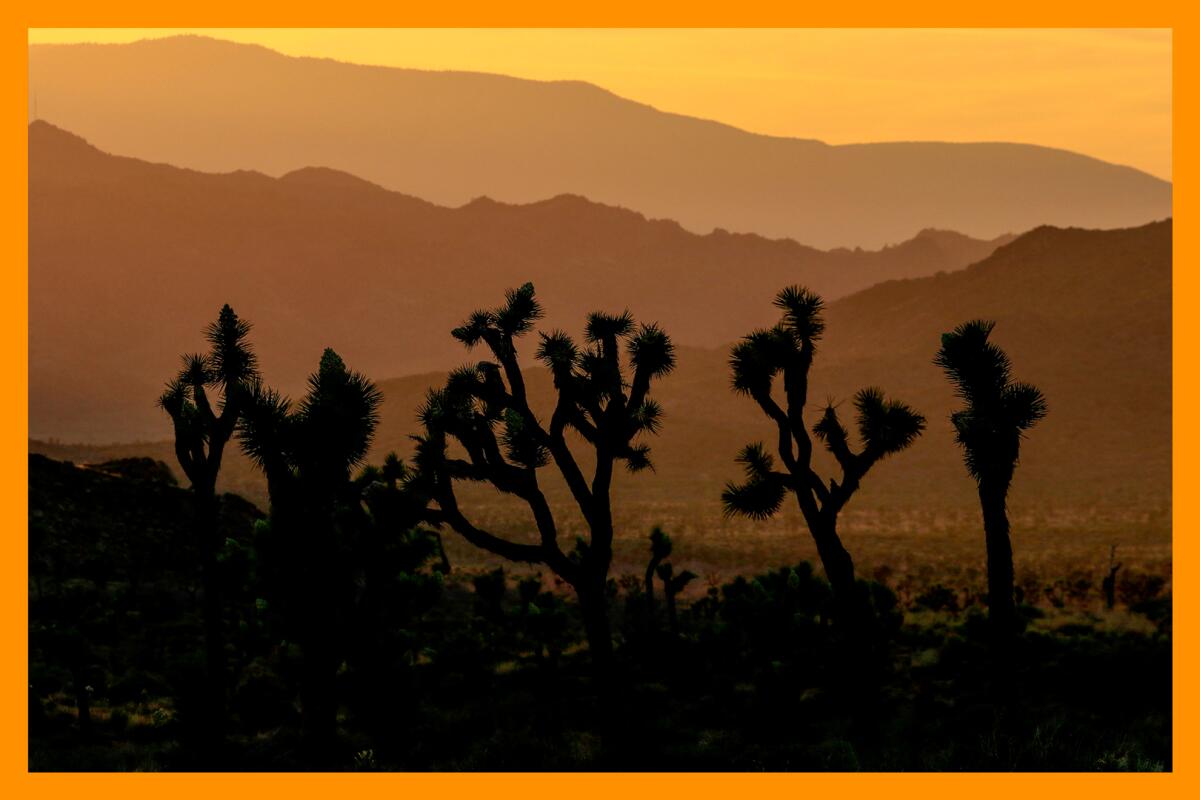
2. Catch a not-so-dry desert conversation. Artist and adventurer Obi Kaufmann is celebrating the release of his book “The Deserts of California: A California Field Atlas” on Nov. 4 from 4 to 6 p.m. The event, hosted by nonprofit Mojave Desert Land Trust, will include a live discussion with Kaufmann — at the organization’s Joshua Tree location — about what environmental justice looks like in the state’s arid regions. Attendees can join in person (tickets, proceeds of which benefit the land trust, are $30) or via livestream (for $15). Additional information and a link to buy tickets are at mdlt.org.

3. Climb that (Joshua) tree in comfort. Speaking of Joshua Tree, now that we’re firmly in fall, it’s one of the high-desert regions known for sweltering summers that’s now seeing more comfortable temperatures. In November, Joshua Tree’s average high is 69 degrees — glorious hiking weather (and a big drop from October’s average high of 81 degrees).
It can be tricky to find last-minute campsites in Joshua Tree National Park, but the Mojave National Preserve, located between Barstow and Needles, requires no advance reservations because it’s managed by the Bureau of Land Management. If you camp, be prepared for chilly overnight temperatures in the mid to low 40s. More info at nps.gov/moja.
The must-read
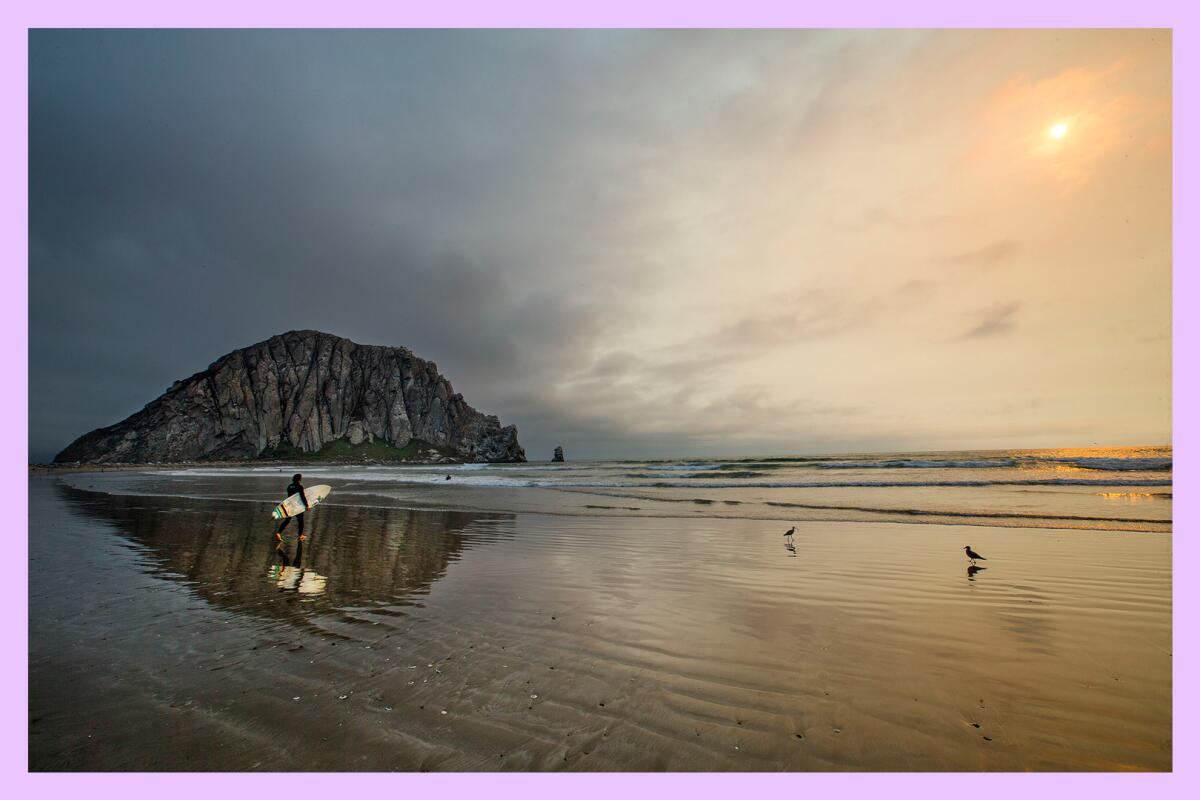
As a 7,573-square-mile marine sanctuary stretching from Cambria to Gaviota nears federal designation, the Native American tribe spearheading the effort has taken issue with a proposed last-minute change — and an iconic Central California rock is caught in the middle. The National Oceanic and Atmospheric Administration recently suggested changing the boundary to remove a stretch of the Central Coast that includes Morro Bay and Morro Rock — a site the Northern Chumash tribe considers sacred — to accommodate the development of an offshore wind farm. Writing for New York Times Travel, Lauren Sloss explores the tension between clean energy and conservation efforts, as well as emerging models for Indigenous co-management of public lands and waters.
Happy adventuring,

P.S.

Have a California native plant lover on your holiday gift list this year? Want to usher the intoxicating scents of the Golden State into your own home? Good news —L.A. Times Plants has partnered with L.A.-based P.F. Candle Co. for a limited-edition candle collection that celebrates native plants.
P.F. Candle Co.‘s development team embarked on hands-on research, hitting local trails, neighborhood nurseries and parks. The results? Three unique fragrances inspired by Jeffrey pine, California walnut and Cowboy Cologne, also known as California sagebrush.
For more insider tips on Southern California’s beaches, trails and parks, check out past editions of The Wild. And to view this newsletter in your browser, click here.
Sign up for The Wild
We’ll help you find the best places to hike, bike and run, as well as the perfect silent spots for meditation and yoga.
You may occasionally receive promotional content from the Los Angeles Times.




